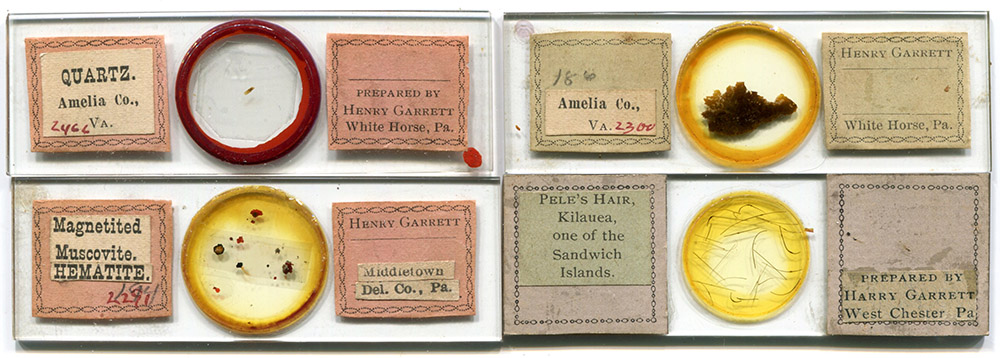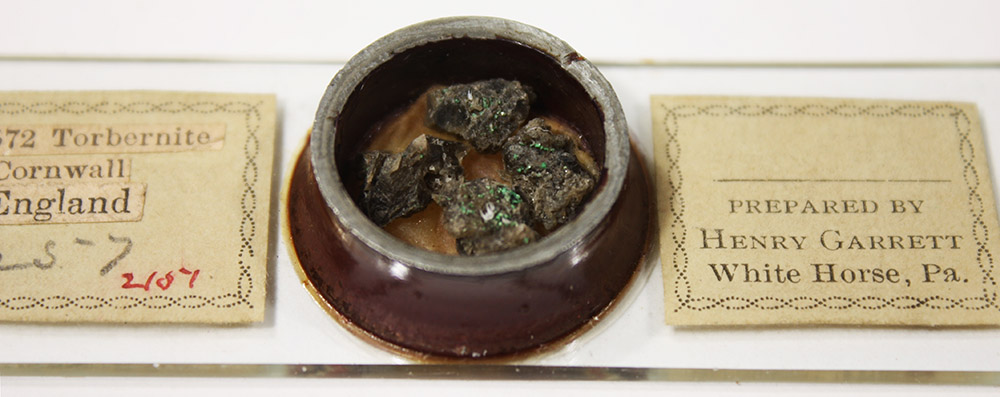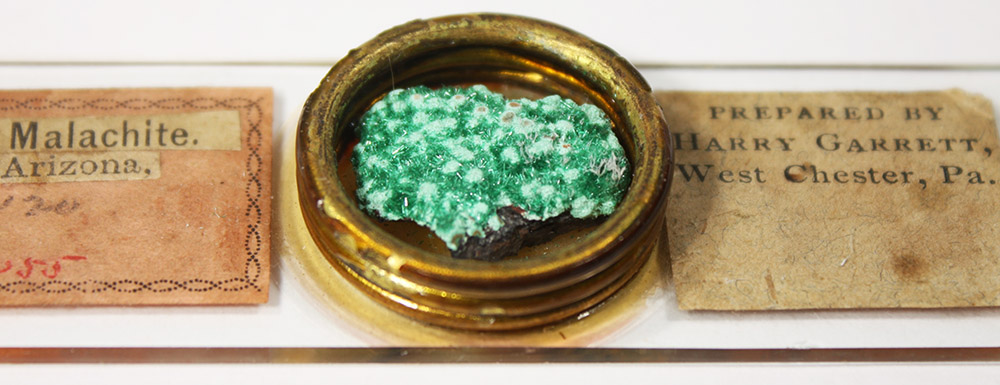Henry (Harry) Garrett, 1839 - 1904
by Brian Stevenson
last updated February, 2020
A farmer in rural Pennsylvania, USA, Henry Garrett developed interests in mineralogy and ornithology. Both of those hobbies evolved into money-making ventures, as a lapidary and a taxidermist. Of particular interest to microscope slide collectors, Garrett produced thin sections of minerals and “micromounts”, that is, small pieces of crystals that are suitable for examination under a microscope. He prepared micromounts on standard 1x3 inch glass slides, making them easy to manipulate on a microscope stage (Figures 1, 2, and 4). He prepared these micromounts both with glass cover slips (keeping the specimens dust-free) and without cover slips (facilitating observations with high-powered objectives). A number of Garrett’s micromounts appear to have lost their cover slips over the years, possibly from breakage, but more likely due to removal by owners who wanted close-up views.

Figure 1.
Microscope slides of thin-mounted minerals, by Henry Garrett. He is first known to have produced slides in 1879, from White Horse, Pennsylvania. He remained in that area until ca. 1886. The slide on the lower left has an address of Middletown pasted over a label that looks identical to those that Garrett used in White Horse. It is not certain when he lived in that township, but the labeling on this slide suggests between ca. 1886 and 1890. Garrett was living in West Chester by 1890, and remained there for the rest of his life.

Figure 2.
Micromounts of crystals, by Henry Garrett. Due the size of the specimens, Garrett built surrounds out of steel washers and tubing, stacks of brass rings, and other materials. Some of these examples evidently once had cover slips, which have either been broken or removed by owners over the years. The slide on the lower left, of pyromorphite, still has its cover slip.
Henry Garrett was born in 1839 to Davis and Elizabeth Garrett, on a farm in rural Willistown township, Pennsylvania. This township includes the White Horse Farm of Elijah Pennypacker (1804-1888), a prominent abolitionist and whose farm was an important stop on the Underground Railroad. Records indicate that Henry Garrett was living in Willistown while also distributing microscope slides from “White Horse” - evidently referring to the area around White Horse Farm, as opposed to the town by that name that is some 30 miles / 50 km away from Willistown. The Garretts and Pennypackers were members of the Society of Friends (“Quakers”). Henry Garrett later purchased, then resold, the mineral collection of Charles Pennypacker (1845-1911).
Garrett was a farmer for most of his life. The 1860 US census listed the 21 year-old Henry as a “farmer”, living with his father (also a “farmer”), mother, sister, a “farm laborer”, and a servant. In 1880, Henry was at the same location, and was head of the farm.
On the ninth day of the tenth month (October 9) of 1873, Henry Garrett married Mary Williams.
The Naturalists’ Directory was a yearly publication through which professional and amateur scientists and collectors could announce their interests and solicit exchanges of material. Henry Garrett was not listed in the 1878 edition, but the 1879 stated that he was interested in ornithology, oölogy, mineralogy, and natural history. In those days, ornithology generally involved killing and preserving birds. Oölogy was collecting birds’ eggs. Garrett’s address was given as “White Horse, Chester Co., Pa.”.
The 1882 edition of The Naturalists’ Directory stated, “Min., Mic. C. Ex. for good spec.”, meaning that Garrett was interested in minerals and microscopy, collected those subjects, and wished to exchange items for good specimens. The 1885 edition asked to exchange “rare Am. and foreign mins. for good spec. only”.
The 1886 edition included a “?”, indicating that the publisher had not heard from Garrett in some time. Henry Garrett’s name was not included in the 1880 edition of The Naturalists’ Directory, indicating a lack of response. Noting the addresses on Garrett’s slides, and his known location in White Horse until ca. 1886 and subsequent residence in West Chester, Pennsylvania in 1890, it is probable that Garrett lived in Middletown, Deleware County, Pennsylvania during the interval between 1886 and 1890. Middletown township is adjacent to Willistown township.
Garrett reappeared in the 1890 edition of The Naturalists’ Directory, with a mark indicating that he had recently contacted the publisher. Giving his address as 36 East Miner street, West Chester, Chester County, Pennsylvania, he expressed interests in geology, mineralogy, microscopy, ornithology, oölogy, herpetology, and taxidermy. The 1892 edition listed similar interests, plus a description of Garrett as “Dealer in minerals. Have thousands of duplicates for sale or exchange”.
He published advertisements to sell or exchange minerals in scientific magazines during 1895 and afterward (Figure 3).
His entry in the 1896 Naturalists’ Directory read, “Garrett, Harry, Taxidermist and Lapidist, 36 East Miner St., West Chester, Chester Co., Pa. Min., Mic. Will exchange Crystals and Cryst. Mms. for Mins. suitable to polish. C. Ex.”.
Garrett’s colleague, Charles Pennypacker, wrote in 1902 on “Specialism in Science”, reporting that “Harry Garrett, of West Chester, is devoting his labors to serpentine”. In another article, Pennypacker wrote, “Harry Garrett, of West Chester, Pa., has about fifty shades of serpentine from various localities in Southeastern Pennsylvania. These are polished so as to display the wonderful symphonies in color and shade. He has furnished many collectors with the results of his labor”.
Henry Garrett died of pneumonia soon afterward, on June 25, 1904.
An ornithological magazine, Cassinia, published this obituary, “Harry Garrett died at his home in West Chester, Pa., June 25, 1904, in his sixty-sixth year. He was the son of the late Davis and Elizabeth Garrett who resided in Willistown township, Chester Co., where Harry was born and passed the greater part of his life. From his parents he inherited a fondness for nature study and his spare hours were devoted to his bird neighbors. He was of a modest, unassuming nature. He did not belong to any of our bird societies, nor did his name often appear in print, yet there are very few who had a more accurate knowledge of our birds, their habits and haunts, than Harry Garrett. A taxidermist of more than ordinary skill, he amassed a very fine mounted collection of local birds, which went to Swarthmore College many years since. About fourteen years ago he moved to West Chester, where he still maintained his interest in birds, though it was divided with mineralogy, in which field he was an enthusiast. Many specimens collected and prepared by Garrett are to be seen in the Josiah Hoopes collection, now in the Academy of Natural Sciences of Philadelphia”.

Figure 3.
An 1895 advertisement from Henry Garrett.

Figure 4.
Circa 1880 Henry Garrett micromount of torbernite from Cornwall.

Figure 5.
Circa 1895 Henry Garrett micromount of malachite from Arizona.
Resources
Cassinia (1904) Obituary of Henry Garrett, page 73
The Naturalists’ Directory (1878) Cassino, Boston
The Naturalists’ Directory (1879) Cassino, Boston, page 71
The Naturalists’ Directory (1882) Cassino, Boston, page 41
The Naturalists’ Directory (1883) Cassino, Boston, page 44
The Naturalists’ Directory (1885) Cassino, Boston, page 57
The Naturalists’ Directory (1886) Cassino, Boston, page 58
The Naturalists’ Directory (1888) Cassino, Boston
The Naturalists’ Directory (1890) Cassino, Boston, page 64
The Naturalists’ Directory (1892) Cassino, Boston, page 76
The Naturalists’ Directory (1896) Cassino, Boston, page 72
The Naturalists’ Directory (1898) Cassino, Boston, page 70
Natural Science News (1895) Advertisement from Henry Garrett, Vol. 1, February issue, page 1
Pennypacker, Charles H. (1901) Tourmaline, Vol. 8, pages 145-147
Pennypacker, Charles H. (1901) Serpentine, Vol. 8, pages 163-166
Pennypacker, Charles H. (1902) Specialism in science, Vol. 8, pages 184-185
U.S. census and other records, accessed through ancestry.com
Wilson, Wendell E. (accessed February, 2020) Charles H. Pennypacker, https://mineralogicalrecord.com/labels.asp?colid=308
Wright, Quentin (1993) The Complete Book of Micromounting, Mineralogical Record, page 20




